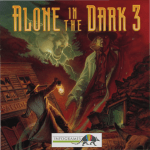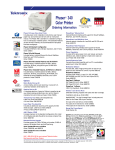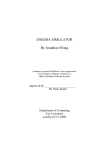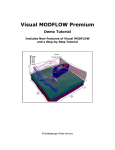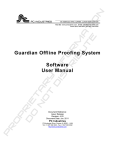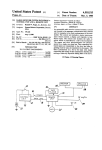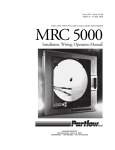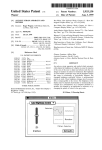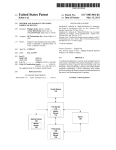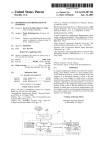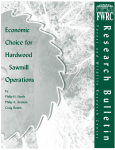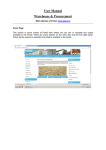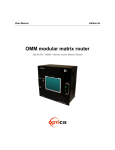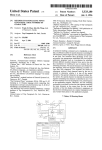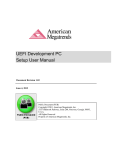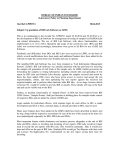Download Method and device for automatic bluetooth pairing
Transcript
US 20070197164Al (19) United States (12) Patent Application Publication (10) Pub. No.: US 2007/0197164 A1 (43) Pub. Date: Sheynman et al. (54) METHOD AND DEVICE FOR AUTOMATIC Aug. 23, 2007 Publication Classi?cation BLUETOOTH PAIRING (76) Inventors: Arnold Sheynman, Northbrook, IL (US); Brian A. Redding, Champaign, IL (US); Michael E. Russell, Lake Zurich, IL (US); Frederick J. Zimbric, (51) Int. Cl. H04B 7/00 (52) US. Cl. (2006.01) .......................................................... .. 455/412 (57) ABSTRACT Described are a method and a Bluetooth device that upon Gurnee, IL (U S) powering up (202), the device automatically enters (306) discoverable mode Without user intervention When its paired Correspondence Address: device list is empty (304). Also described is emptying (206) MOTOROLA INC 600 NORTH US HIGHWAY 45 ROOM AS437 the paired device list. Further described is a method and LIBERTYVILLE, IL 60048-5343 (US) Bluetooth device having one or more devices listed in its paired device list and Wherein attempts are made at com munication With the listed devices in one or more predeter mined manners and if the attempts are not successful, automatically entering discoverable mode (306). Still further (21) Appl. No.: described is a method and device for attempting communi 11/362,295 cation With the previously paired devices Which may be interposed With entering into discoverable mode until either (22) Filed: Feb. 23, 2006 one is successful. 202 ' POWER UP BLUETOOTH DEVICE I ESTABLISH COMMUNICATION 204‘- AND ADD TESTING DEVICE TO PAIRED DEVICE LIST Y 206 - EMPTY PAIRED DEVICE LIST I 208" POWER DOWN BLUETOOTH DEVICE POWER UP BLUETOOTH DEVICE 212_ AUTOMATICALLY ENTER INTO DISCOVERABLE MODE Patent Application Publication Aug. 23, 2007 Sheet 2 0f 4 202’ POWER UP BLUETOOTH DEVICE I ESTABLISH COMMUNICATION 204'- AND ADD TESTING DEVICE TO PAIRED DEVICE LIST I 206" EMPTY PAIRED DEVICE LIST I 208__ POWER DOWN BLUETOOTH DEVICE I 210“ POWER UP BLUETOOTH DEVICE I 212___ AUTOMATICALLY ENTER INTO DISCOVERABLE MODE FIG. 2 US 2007/0197164 A1 Patent Application Publication Aug. 23, 2007 Sheet 3 0f 4 US 2007/0197164 A1 302\ POWER UP BLUETOOTH DEVICE 304 f 308 IS THERE A DEVICE YES LISTED IN PAIRED DEVICE LIST? M ATTEW;I$SEMSJQ(IS:¢TION 306 \ 310 DETERMINE IF SUCCESSFUL COMMUN|CAT|ON ATTEMPT? AUTOMATICALLY ENTER DISCOVERABLE MODE f‘ 312 CONNECT FIG. 3 Patent Application Publication Aug. 23, 2007 Sheet 4 0f 4 31 A \ a\?> 1% m \ NE LII wt. m3 m \w\ _ _ _ _ A _ m SE _ _ _ _ _‘ _ - US 2007/0197164 A1 EmwsazE<. .bbww 87 Al 05H Aug. 23, 2007 US 2007/0197164 A1 the slave device. For example, When the telephone initiates METHOD AND DEVICE FOR AUTOMATIC BLUETOOTH PAIRING the discovery and pairing procedure it behaves as a master FIELD poWers the headset up the headset actively looks for the and the headset becomes a slave. Next time When the user [0001] Described are a method and a Bluetooth device that upon powering up, the device automatically enters discov erable mode, and more particularly, disclosed is a method and device that establishes communication With another Bluetooth enabled device Without user intervention. BACKGROUND previously paired telephone, initiates connection to it and becomes a master. Upon accepting connection, the telephone becomes a slave. Furthermore, during the ongoing connec tion the master/slave roles can be sWitched if required. [0007] When a connection has been established betWeen the Bluetooth device such as a headset and another Blue [0002] Bluetooth (BT) Wireless technology provides a tooth device, such as a telephone, a paired device list Will list those devices With Which a connection has been established manner in Which many Wireless devices may communicate With one another, Without connectors, Wires or cables. devices is presented to the user. The user may select the Bluetooth technology uses the free and globally available unlicensed 2.4 GHZ radio band, for loW-poWer use, alloWing desired device to be paired With. In one example, the Bluetooth device is a headset, and another Bluetooth device and the Link Key has been exchanged. The list of discovered tWo Bluetooth devices Within a range of up to 10 to 100 is a mobile communication device such as a cellular tele meters to share data With throughput up to 2.1 Mbps. Each Bluetooth device can simultaneously communicate With many other devices. phone. [0003] Current common uses for Bluetooth technology include those for headsets, cellular car kits and adapters. Moreover, Bluetooth technology is currently used for con necting a printer, keyboard, or mouse to a personal computer Without cables. Also, since Bluetooth technology can facili tate delivery of data, computers may use Bluetooth to provide a connection to the Internet. Mobile communication devices such as cellular telephones may transfer photos, video or ring tones betWeen them. Additional functionality is expected to continue to expand. [0004] Before tWo Bluetooth enabled devices may com municate, the devices must be paired. Bluetooth pairing occurs When the tWo Bluetooth enabled devices, unknoWn to each other, become a trusted pair. To become a trusted pair, the tWo Bluetooth devices must ?rst complete a speci?c discovery and authentication process. When a ?rst Bluetooth device recogniZes a second Bluetooth device and they complete the speci?c discovery and authentication process, each device can automatically accept communication betWeen them. [0005] Device discovery is the procedure a Bluetooth Wireless device uses to locate nearby Bluetooth Wireless devices With Which it Wishes to communicate. Exchanging the Bluetooth addresses of the discoverable devices, their friendly names and other relevant information via establish ing a short term connection With each device in the vicinity can be a time consuming procedure. The procedure can involve having one Bluetooth Wireless device transmitting [0008] During the device discovery procedure it is pos sible to obtain further information from discoverable devices such as the Bluetooth devices friendly names. Accordingly, the discovering device sends a page request to Bluetooth device address(es) of the discovered device(s), at Which point the discovering device initiates a short term connection With the discoverable device(s) and becomes a master. When a discoverable device responds to a page request, it becomes a slave. At this point, the devices are not paired, but the master can send a request for the slave’s friendly name. For example, the friendly name may look like “Bluetooth Head set”. [0009] Typically instead of the hexadecimal Bluetooth addresses the paired device list of devices’ friendly names is presented to the user at the end of the discovery procedure. At this moment the user can select the Bluetooth Wireless device he/ she desires to start the communication With. After the user makes a selection, the discovering device can initiate a connection With the neWly discovered device using the discovered device’s Bluetooth device address. Without device discovery a Bluetooth Wireless device Would not knoW the Bluetooth device address of other Bluetooth devices Which is required information for establishing a connection betWeen the devices. [0010] While in principal, the discovery process may be completed by folloWing particular steps, oftentimes users are unsure of the procedure. In some situations, users may be unable to facilitate communication With previously paired device or are unable to complete the discovery process an inquiry request to other Bluetooth Wireless devices scan betWeen tWo devices. In such a case, a Bluetooth accessory ning for inquiry requests. A device that transmits the inquiry request (a potential master) is said to be discovering other Would be bene?cial Were there feWer steps that a user must devices, or in discovering mode, While the device that is scanning for inquiry requests is said to be discoverable. The tooth devices, such as a headset and a cellular telephone. discoverable device (a potential slave) performs a process called inquiry scanning, during Which it looks for an inquiry request. Once a discoverable device receives an inquiry request, it responds With Frequency Hopping Synchroniza tion (FHS) packets. These packets include, among other ?elds, the discoverable device’s 6-byte Bluetooth device address and 3-byte Class of Device (COD). [0006] The master device is a device that initiates a connection. The device that accepts a connection becomes in particular may not be useful to them. Accordingly, it accomplish to establish communication betWeen tWo Blue BRIEF DESCRIPTION OF THE DRAWINGS [0011] The accompanying ?gures, Where like reference numerals refer to identical or functionally similar elements throughout the separate vieWs and Which together With the detailed description beloW are incorporated in and form part of the speci?cation, serve to further illustrate various embodiments and to explain various principles and advan tages all in accordance With the present invention. Aug. 23, 2007 US 2007/0197164 A1 [0012] FIG. 1 depicts two exemplary Bluetooth devices tion. The disclosure is further offered to enhance an under including a mobile communication device and a headset standing and appreciation for the invention principles and device; advantages thereof, rather than to limit in any manner the [0013] FIG. 2 is a ?ow chart of an exemplary embodiment where in a testing process the paired device list may be invention. The invention is de?ned solely by the appended claims including any amendments of this application and all populated by the testing device and subsequently emptied; equivalents of those claims as issued. [0014] FIG. 3 is a ?owchart of the exemplary Bluetooth device determining the state of its paired device list and either attempting communication with paired devices or [0022] It is further understood that the use of relational terms, if any, such as ?rst and second, top and bottom, and the like are used solely to distinguish one from another entity or action without necessarily requiring or implying any entering into discoverable mode; and timing for two Bluetooth enabled devices in the process of actual such relationship or order between such entities or actions. The terms “comprises,”“comprising,” or any other establishing communication. variation thereof, are intended to cover a non-exclusive [0016] Skilled artisans will appreciate that elements in the ?gures are illustrated for simplicity and clarity and have not necessarily been drawn to scale. For example, the dimen inclusion, such that a process, method, article, or apparatus that comprises a list of elements does not include only those elements but may include other elements not expressly listed or inherent to such process, method, article, or apparatus. An [0015] FIG. 4 is an exemplary timing diagram showing sions of some of the elements in the ?gures may be exag gerated relative to other elements to help to improve under standing of embodiments of the present invention. DETAILED DESCRIPTION [0017] Described are a method and a Bluetooth device that upon powering up, the device enters discoverable mode without user intervention when its paired device list is empty. Also described is emptying the paired device list. Further described is a method and Bluetooth device having one or more devices listed in its paired device list and wherein attempts may be made at communication with the listed devices in one or more predetermined manners, and if the attempts are not successful, automatically entering dis coverable mode. Still further described is a method and device for attempting communication with the previously paired devices that may be interposed with entering into discoverable mode until either one is successful. [0018] Accordingly, described is an embodiment in a Bluetooth device including a memory that can store a paired device list. The paired device list can list other Bluetooth enabled devices with which the Bluetooth device was pre element proceeded by “comprises . . . a” does not, without more constraints, preclude the existence of additional iden tical elements in the process, method, article, or apparatus that comprises the element. [0023] Much of the inventive functionality and many of the inventive principles are best implemented with or in software programs or instructions and integrated circuits (ICs) such as application speci?c ICs. It is expected that one of ordinary skill, notwithstanding possibly signi?cant e?fort and many design choices motivated by, for example, avail able time, current technology, and economic considerations, when guided by the concepts and principles disclosed herein will be readily capable of generating such software instruc tions and programs and ICs with minimal experimentation. Therefore, in the interest of brevity and minimization of any risk of obscuring the principles and concepts according to the present invention, further discussion of such software and ICs, if any, will be limited to the essentials with respect to the principles and concepts within the preferred embodi ments. viously paired. The method includes powering up the Blue [0024] FIG. 1 depicts two Bluetooth devices including an exemplary mobile communication device and an exemplary tooth device, determining whether there is a device listed in headset device. Shown are a Bluetooth device 102 and a a paired device list and automatically entering discoverable mobile communication device 104 having Bluetooth capa mode if there is no device listed in a paired device list. bilities. The Bluetooth device as used in this discussion is any Bluetooth enable communication device. A cellular telephone may be a slave to another cellular telephone. More typically, a Bluetooth device may be a peripheral to another Bluetooth enabled device. For example, a Bluetooth enabled [0019] Also described is an embodiment in a Bluetooth device including powering up the Bluetooth device and then determining whether there is a device listed in a paired device list. If the paired device list is not empty, the method includes attempting communication with at least one device listed in the paired device list. If attempting communication with one or more devices in the device list is not successful, the method can include automatically entering discoverable mode. [0020] In another embodiment, attempting communica tion with devices in the pair device list may be interposed with entering discoverable mode, until either of the pro cesses is successful. In this manner, user intervention is avoided since the processes of attempting communication and the entering into discoverable mode is automatic. [0021] The instant disclosure is provided to further explain in an enabling fashion the best modes of making and using various embodiments in accordance with the present inven mouse may be a slave to a Bluetooth enabled personal computer or laptop computer. In any event both the Blue tooth device and the mobile communication device can be any type of device that is Bluetooth enabled. [0025] A wide variety of Bluetooth enabled devices that have been developed and will be developed for use within various networks are included in this discussion. Handheld communication devices include, for example, cellular tele phones, messaging devices, mobile telephones, personal digital assistants (PDAs), notebook or laptop computers incorporating communication modems, mobile data termi nals, application speci?c gaming devices, video gaming devices incorporating wireless modems, audio and music players and the like. Bluetooth enabled industrial devices may also be paired as described herein. Other devices such Aug. 23, 2007 US 2007/0197164 A1 as personal computers, television sets and stereo equipment may also be paired With Bluetooth devices in the manner described herein. [0026] The Bluetooth device 102 depicted in FIG. 1 can include a transceiver 106, a processor 108, memory 110, and modules 112. The mobile communication device 104 can similarly include a transceiver 114, a processor 116, memory 118, and modules 120. [0027] The Bluetooth device 102 and the mobile commu nication device 104 are depicted With modules 112 and 120 respectively that can contain instruction modules that can be hardWare and/or softWare to carry out various tasks. The modules can carry out certain processes of the methods as described herein. The modules can be implemented in be electronically effected or may be performed automati cally. In the factory or distribution chain, a signal or elec tronic input may be sent to the Bluetooth device to clear or empty the paired device list. On the other hand, a manual input method or command to return the Bluetooth device into a “fresh” condition can be implemented by an input device such as a multifunction button in communication With its processor. The manual process to empty the paired device list can be for example, to press the multifunction button three consecutive times While the volume up button and the volume doWn button are continuously pressed. In any event, the device can be put into a “fresh” condition in any suitable manner. The device can be thereafter poWered doWn 208. softWare, such as in the form of one or more sets of prestored [0031] After emptying the paired device list, the Bluetooth instructions, and/or hardWare, Which can facilitate the opera device may be poWered up 210. For example, the device tion of the mobile communication device or Bluetooth device as discussed beloW. The modules may be installed at the factory or can be installed after distribution by, for may be delivered to the end user With an empty paired example, a downloading operation. The operations in accor dance With the modules Will be discussed in more detail beloW. [0028] The modules of the headset 102 and the mobile communication device 104 are illustrated as being similar. Of course, any other modules may be part of those devices. device list. With the empty paired device list, the Bluetooth device can automatically be placed into discoverable mode 212. Accordingly, the Bluetooth device that is in discover able mode can engage another Bluetooth enabled device in communication. Since the device may enter discoverable mode When its paired device list is empty, the user may not be required to folloW procedures or instructions to place the device in discoverable mode When it is in its “fresh” A discoverable mode module 122, list determining module condition, having an empty paired device list. 124 and attempting module 126 of the headset 102 are [0032] The other Bluetooth enabled device (see 104, FIG. 1) With Which the Bluetooth device (see 102, FIG. 1) becomes engaged can then populate the paired device list (see 140, FIG. 1). Accordingly, the Bluetooth device may similarly shoWn With the mobile communication device 104 as discovery mode module 128, list determining module 130 and attempting module 132. If the roles of the devices Were reversed, then headset 102 may have a discovery mode module and mobile communication device 104 may have a discoverable mode module. While mobile communication device 104 is shoWn With a display device 134 and an input device 136, similar devices may be included in the headset 102. [0029] FIG. 1 may depict a circumstance Where at the factory or along the distribution chain for the headset 102 Where for quality testing purposes, it may be paired With a device 104 or another device such as a testing device. Communication 138 may be established betWeen headset 102 and device 104 and thus the device 104 may be added to the paired device list. In memory 110 of the tested headset 102, there may be a paired device list Which may list all the devices With Which headset 102 has established communi cation. The paired device list 140 shoWs that headset 102 has established communication With mobile communication device 104. As mentioned, in a factory or distribution chain process, the device 104 may be a testing device speci?cally designed for quality assurance. [0030] FIG. 2 is a How chart of an embodiment Where in a testing process the paired device list (see 140 of FIG. 1) may be populated by the testing device identi?cation and may be subsequently emptied. The testing process may folloW steps including poWering up the Bluetooth device 202 and through the discovery process, establishing com munication 204 such as that shoWn (see 138) betWeen the devices of FIG. 1. Accordingly, the paired device list may be populated by the testing device identi?cation name or code. Before the device is distributed, the paired device list can be emptied 206. The paired device list emptying procedure may include manual or speech input to the Bluetooth device, may have one or more devices on its paired device list. After its initial poWer up, the Bluetooth device may be poWered up a second time. In that event, if the list is populated, the device may attempt to communication With at least one device listed in the paired device list. If the attempt to establish communication With a device in the pair device list has failed, then the device can enter discoverable mode, auto matically or by prompt. The reason for a failed attempt may be that the listed devices are not turned on or are not Within range. Also, the user may Wish to pair the Bluetooth device With another Bluetooth enabled device other than those listed in the paired device list. Accordingly, the user can position the neW Bluetooth enabled device Within range of the Bluetooth device so that after the failed attempts at communication With devices in the paired device list, the Bluetooth device may be placed in discoverable mode. [0033] FIG. 3 is a ?owchart of the Bluetooth device determining the state of its paired device list and either attempting communication With paired devices or entering into discoverable mode. The Bluetooth device is poWered up 302 and there is a determination Whether the paired device list is empty or populated 304. A list determining module may provide the instructions. If there is no device listed in the paired device list then the Bluetooth device automati cally enters into discoverable mode 306. If the pair device list is nonempty 304, then a communication attempt is made With one or more Bluetooth enabled devices on the list 308. An attempting module may provide the instructions. If the attempt to communicate With device or devices on the paired device list is successful 310, then a connection may be established 312. If the attempt to communicate With a device or devices on the paired device list fails, then the Bluetooth Aug. 23, 2007 US 2007/0197164 A1 device may automatically enter into discoverable mode 306. A discoverable mode module may provide the instructions. [0039] [0034] It may be that the time required for scanning all time. They may be the same length or different lengths, or knoWn devices on the paired device list in an attempt to make communication 308 can be signi?cant, such as for example betWeen ?ve to ten seconds for each one. If there are a number of devices on the paired device list, scanning The tWo shoWn times tS 406 and 408 are similar in length and therefore extend for a predetermined period of extending for random periods of time. HoWever, time tall 410 through them all may be time consuming. Accordingly, the and time t‘,12 412 are shoWn as different lengths of time, but may be the same length. That is, the time tall 410 and time t‘,12 412 may be the same for a predetermined period of time, may be for predetermined different periods of time, or may user may ?nd the time to attempt to make connection 308 be for random periods of time. With all the devices in the paired device list too long. Therefore, a criterion may be placed upon the scanning process. [0040] As FIG. 4 shoWs, the headset 402 interposes tWo processes. It both attempts communication With devices on It may be likely that the last device in the paired its paired devices list and it enters into discoverable mode. As shoW in FIG. 4, the handset 404 in discovering mode is device list is the one in close proximity so that communi cation can be established. Therefore, there may be an nearby and therefore inquiry or inquiries may be received by [0035] embodiment for attempting communication 308 including ?rst attempting communication With the most recently paired device on the paired device list. Alternatively, another embodiment may be ?rst attempting to communicate 308 With a plurality of the most recently paired devices on the paired device list. [0036] Different connection attempting schemes or strat egies 308 are possible. For example, after the Bluetooth device attempts communication With the last tWo recently paired devices in the paired device list, and there is failure to communicate 310, the device may automatically enter discoverable mode 314. Any variation in number or order of attempts to communicate and then automatically entering the headset 402 When it is in discoverable mode. ArroW 414 shoWs that during one of the discoverable mode intervals, time t‘,12 412, the headset 402 may respond to the discover able mode inquiry by the handset 404. In another embodi ment, the discoverable mode interval may be adaptive. Accordingly, even though the discovery process Was set for a predetermined time t‘,12 412, it is possible that the process may not be completed during that particular time interval of a certain length. Accordingly, the process may continue through time delta. The headset 404 therefore may be con?gured to adaptively increase the time t‘,12 412 to time td2+delta to complete the discovery process betWeen the handset and the headset. discoverable mode is Within the scope of this discussion. [0041] [0037] It may be that the time required for discoverable communicate With one or more devices in the paired device mode for either device, the Bluetooth device such as a headset and the Bluetooth enable device such as a mobile communication device, varies from manufacturer to manu fails, the Bluetooth device may be con?gured to empty its facturer. Accordingly, time for establishing communication during discoverable mode may be variable from device to device. To avoid losing an opportunity to either establish communication With a device on the paired device list, or establish communication in discoverable mode, the tWo processes may be interposed. An embodiment can therefore include interposing periods during Which the Bluetooth device is in discoverable mode betWeen periods of attempt ing communication With the plurality of devices until a criterion is met. The criterion may be that an attempted communication With a device on the paired device list has been successful. Alternatively, a criterion may be that dis covery has been successful. Other criteria are Within the scope of this discussion. [0038] FIG. 4 is a timing diagram shoWing timing for tWo Bluetooth enabled devices in the process of establishing communication. For example, timing is shoWn for the head set time 402 and the handset time 404. Any type of Bluetooth enabled device may be represented in a similar manner. The In the event that the process of attempting to list fails, and establishing communication in discovery mode paired device list to start as a “fresh” device. Different methods for emptying the paired device list Were mentioned above. Once the paired device list is empty, the Bluetooth device, upon poWering up can automatically enter discov erable mode, and therefore receive an inquiry from a device similarly in discoverable mode. [0042] In summary, a Bluetooth device may upon poWer ing up, automatically enter discoverable mode Without user intervention. In the case Where the paired device list is empty, the Bluetooth device maintains the discoverable mode until an inquiry from a different Bluetooth enabled device is received or timeout occurs. If the paired device list is non-empty, after attempting communication With a device in the paired device list, the Bluetooth device may be placed into discoverable mode. In another embodiment, in the case Where one or more devices are listed in the paired device list, attempting communication With the devices and entering into discoverable mode may be interposed until either one is successful. Accordingly, the aforementioned or other criteria have therefore been met. tS may represent the scan time, that is, the time for attempting communication With devices on the paired device list, for [0043] example, in the manner in Which Was described above. fashion and use various embodiments in accordance With the lnterposed betWeen time ts, are time tall and time td2. The technology rather than to limit the true, intended, and fair scope and spirit thereof. The foregoing description is not number of interposed time elements may be more or less than that shoWn in FIG. 4. TLFD may represent the time the This disclosure is intended to explain hoW to handset device is in discovering mode (see FIG. 1, discovery intended to be exhaustive or to be limited to the precise forms disclosed. Modi?cations or variations are possible in mode module 128). In the case of the handset 404, it is shoWn that the device is in discovering mode for the time light of the above teachings. The embodiment(s) Was chosen and described to provide the best illustration of the principle of the described technology and its practical application, and Aug. 23, 2007 US 2007/0197164 A1 to enable one of ordinary skill in the art to utilize the technology in various embodiments and With various modi ?cations as are suited to the particular use contemplated. All such modi?cations and variations are Within the scope of the invention as determined by the appended claims, as may be amended during the pendency of this application for patent, and all equivalents thereof, When interpreted in accordance With the breadth to Which they are fairly, legally and equitable entitled. 8. The method of claim 6, further comprising: retrieving a plurality of the most recently paired device from the paired device list to attempt communication thereWith. 9. The method of claim 6, further comprising: emptying the paired device list. 10. The method of claim 6, Wherein the paired device list comprises a plurality of devices, the method further com prising: 1. A method in a Bluetooth device having a memory con?gured to store a paired device list, the method com prising: poWering up the Bluetooth device; determining Whether there is a device listed in a paired device list; and entering automatically discoverable mode if there is no device listed in a paired device list. 2. The method of claim 1, further comprising: adding a device to the paired device list; and emptying the paired device list. 3. The method of claim 2, further comprising: providing a user manual command to empty the paired device list. 4. The method of claim 2, further comprising: providing a speech command to empty the paired device list. interposing periods during Which the Bluetooth device is in discoverable mode betWeen periods of attempting communication With the plurality of devices until a criterion is met. 11. The method of claim 10, Wherein attempting commu nication continues for a predetermined period of time. 12. The method of claim 10, Wherein attempting commu nication continues for a random period of time. 13. The method of claim 10, Wherein the Bluetooth device remains in discoverable mode for a predetermined period of time. 14. The method of claim 10, Wherein the Bluetooth device remains in discoverable mode for a random length of time. 15. The method of claim 10, Wherein the criterion com prises that attempting communication With at least one device is successful. 16. The method of claim 10, Wherein the criterion com prises that attempting communication With the plurality of devices is unsuccessful. 17. A Bluetooth device, comprising: 5. The method of claim 2, further comprising: a memory unit con?gured to store instructions; providing an electronic input to the Bluetooth device to empty the paired device list. 6. A method in a Bluetooth device having a memory con?gured to store a paired device list, the method com prising: poWering up the Bluetooth device; determining Whether there is a device listed in a paired device list; attempting communication With at least one device listed in the paired device list if the paired device list is nonempty; and entering discoverable mode if attempting communication With the at least one device is unsuccessful. 7. The method of claim 6, further comprising: retrieving the most recently paired device from the paired device list to attempt communication thereWith. a processor con?gured to execute instructions stored in the memory unit; and a discoverable mode module With instructions con?gured to place the Bluetooth device in discoverable mode Without user action When a criterion is met. 18. The Bluetooth device of claim 17, Wherein the memory unit is further con?gured to store a paired device list, and Wherein the criterion comprises that no devices are listed in a paired device list. 19. The Bluetooth device of claim 17, Wherein the memory unit is further con?gured to store a paired device list, and Wherein the criterion comprises that attempting communication With at least one device on the paired device list has failed. 20. The Bluetooth device of claim 17, Wherein the Blue tooth device is a headset. * * * * *











